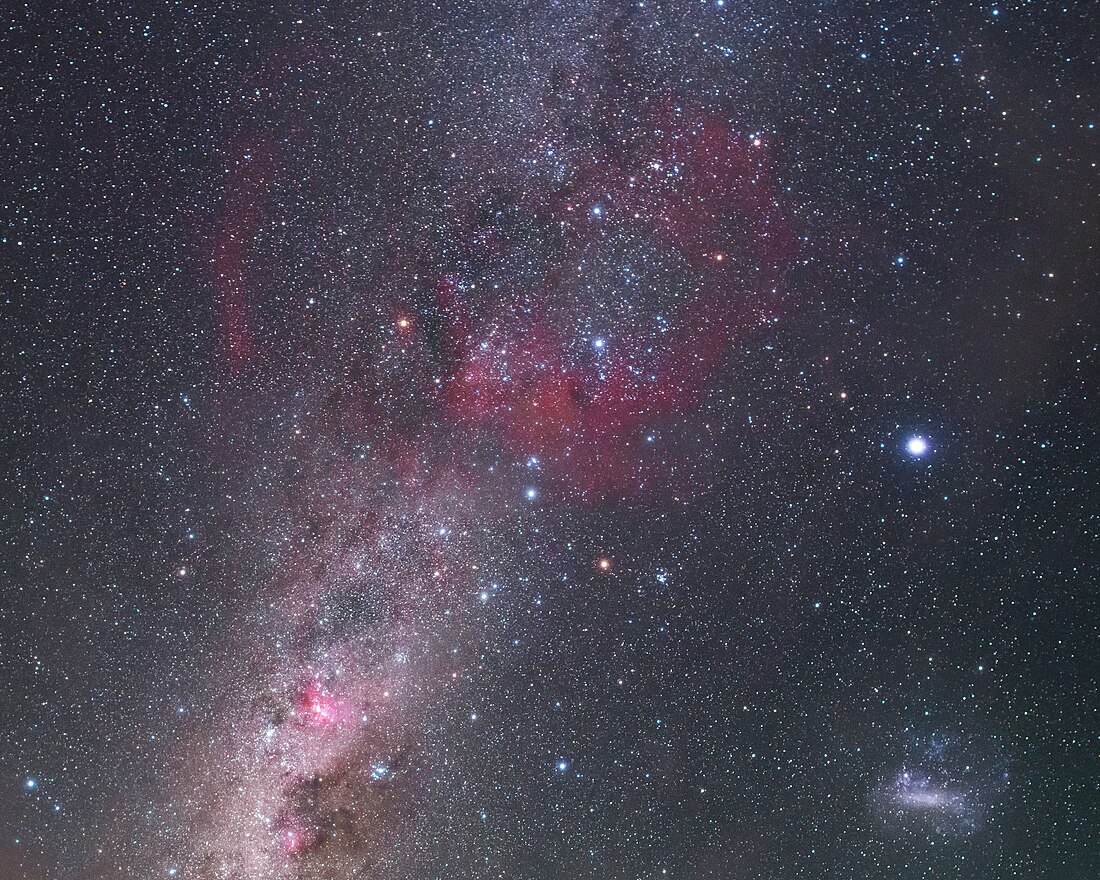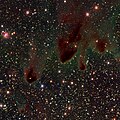Top Qs
Timeline
Chat
Perspective
Gum Nebula
Emission nebula From Wikipedia, the free encyclopedia
Remove ads
The Gum Nebula (Gum 12) is an emission nebula that extends across 36° in the southern constellations Vela and Puppis. It lies approximately 450 parsecs from the Earth.[1] Hard to distinguish, it was widely believed to be the greatly expanded (and still expanding) remains of a supernova that took place about a million years ago. More recent research suggests it may be an evolved H II region. It contains the 11,000-year-old Vela Supernova Remnant, along with the Vela Pulsar.[2]
You can help expand this article with text translated from the corresponding article in Italian. (October 2015) Click [show] for important translation instructions.
|
It is located between the two bright and massive stars system Naos (ζ Puppis) and Regor (γ² Velorum), the former is closer to the edge of the cloud facing the Sun , at a distance of about 330 ± 10 parsecs, while the latter, at about 336+8
−7 parsecs, is located closer to the center of the cloud. To its southeastern part lies the Vela Nebula , a supernova remnant that lies between the Gum Nebula and the Solar System, along the same line of sight.
The Gum Nebula is one of the largest known nebulae within the Milky Way and constitutes an important scenario for the study of the expansion of bubbles generated by supernova explosions within the environment of the galactic arms, as well as on the interaction between these and the surrounding molecular clouds ; in fact, on the edges of the cloud some limited star formation phenomena are active , localized in small clouds (known as cometary globules due to their appearance). Near some of these globules some HH objects are also found , including HH 47.[3]
Remove ads
Description
Summarize
Perspective

The Gum Nebula contains about 32 cometary globules.[4] These dense cloud cores are subject to such strong radiation from O-type stars γ2 Vel and ζ Pup and formerly the progenitor of the Vela Supernova Remnant that the cloud cores evaporate away from the hot stars into comet-like shapes. Like ordinary Bok globules, cometary globules are believed to be associated with star formation.[5] A notable object inside one of these cometary globules is the Herbig-Haro object HH 46/47.
The main ionizing sources are the Vela OB2 association (including Gamma Velorum cluster and the P Puppis cluster), Zeta Puppis and the OB association Trumpler 10.[6][7] The star cluster NGC 2547 formed 100 pc more distant than Vela OB2 and is an interloper.[7] The Vela OB2 association is surrounded by the so-called "IRAS Vela Shell", located in the south of the Gum Nebula. The star clusters NGC 2547, Trumpler 10, NGC 2451B, Collinder 135 and Collinder 140 all have similar ages of about 30 Myrs. It is suggested that a few stars exploded in supernovae about 30 Myrs ago in the center of the Gum Nebula and triggered the formation of stars in the region.[8]
It is named after its discoverer, the Australian astronomer Colin Stanley Gum (1924–1960). Gum had published his findings in 1955 in a work called A study of diffuse southern H-alpha nebulae (see Gum catalog). He also published the discovery of the Gum Nebula in 1952 in the journal The Observatory. The observations were made with the Commonwealth Observatory.[9]
The Gum nebula was photographed during Apollo 16 while the command module was in the double umbra of the Sun and Earth, using high-speed Kodak film.[10]
Remove ads
Popular culture
The Gum Nebula is explored by the crew of the Starship Titan in the Star Trek novel Orion's Hounds.[11]
Gallery
- H-alpha Image of Gum Nebula
- Clouds near the center of the Gum Nebula
- Cometary Nebulae 30, 31 and 38 in the Gum Nebula. It also contains HH 120.
- Environment in the Gum Nebula with HH 46/7 (middle-right)
- Vela OB2 with its brightest star Gamma2 Velorum is located in the Gum Nebula. The image also contains the smaller star cluster NGC 2547 in the lower left part.
- One of 4 images of the Gum Nebula photographed by Apollo 16 in 1972. AS16-127-20024.
See also
References
External links
Wikiwand - on
Seamless Wikipedia browsing. On steroids.
Remove ads







